2012 VOLKSWAGEN GOLF MK6 steering wheel
[x] Cancel search: steering wheelPage 187 of 516

When an airbag deploys , fine dust is released.
This is normal and is not caused by a fire in the hicle . This dust is made up mostly of a powder
used to lubricate the airbags as they deploy. This
dust could irritate skin and eyes and cause
ciently when used with properly worn safety belts
and a proper seating position in Introduct ion on page 58
equipment
Your safety and the safety of your passenge rs
shouldn't be left to c hance. Advances in
gy have made a number of featu res availab le to
help reduce the risk of injury in a collision . The
Sophisticated safety belts for
belt pretensioners for driver and front
passenger .
Advanced front airbag system for driver and
front passenger .
ger.
Airbag indicato r
BAG light.
Electronic control unit and associa ted sensors.
Before driving
Head restraints with height adjustmen t
Adjustable steering column.
LATCH/U CRA lower universal and top tether
anchorages for child safety seats at the rear
These features
can't work as a system if they are not always
be tu rned
off if the weight on the front passe nger seat is less
than the amount programmed in the elect ronic
con t
rol unit . Th e front airbag on the passenge r side
will also be turned off if the combine d weigh t of an
i nfant
of about one year of age in one of the child
seats that was used to certify the Advanced Airbag
ard BAG
Never rely on airbags alone for protection.
69, Safety belts.
ery per son in the vehicle is properly seated on a sea t of his or her own, properly fastens the safety belts belonging to that seat before the vehicle starts to move, and keeps the belts properly fasten ed while riding i n the hicle. This applies eve n when just driving around town. Therefore, always wear your safety belts and make sure that everybody in your vehicle is properl y restrai ned .
too close to the steering wheel or strument panel decrease the ness of the airbags and will increase the risk of personal injury in a collision.
Page 276 of 516
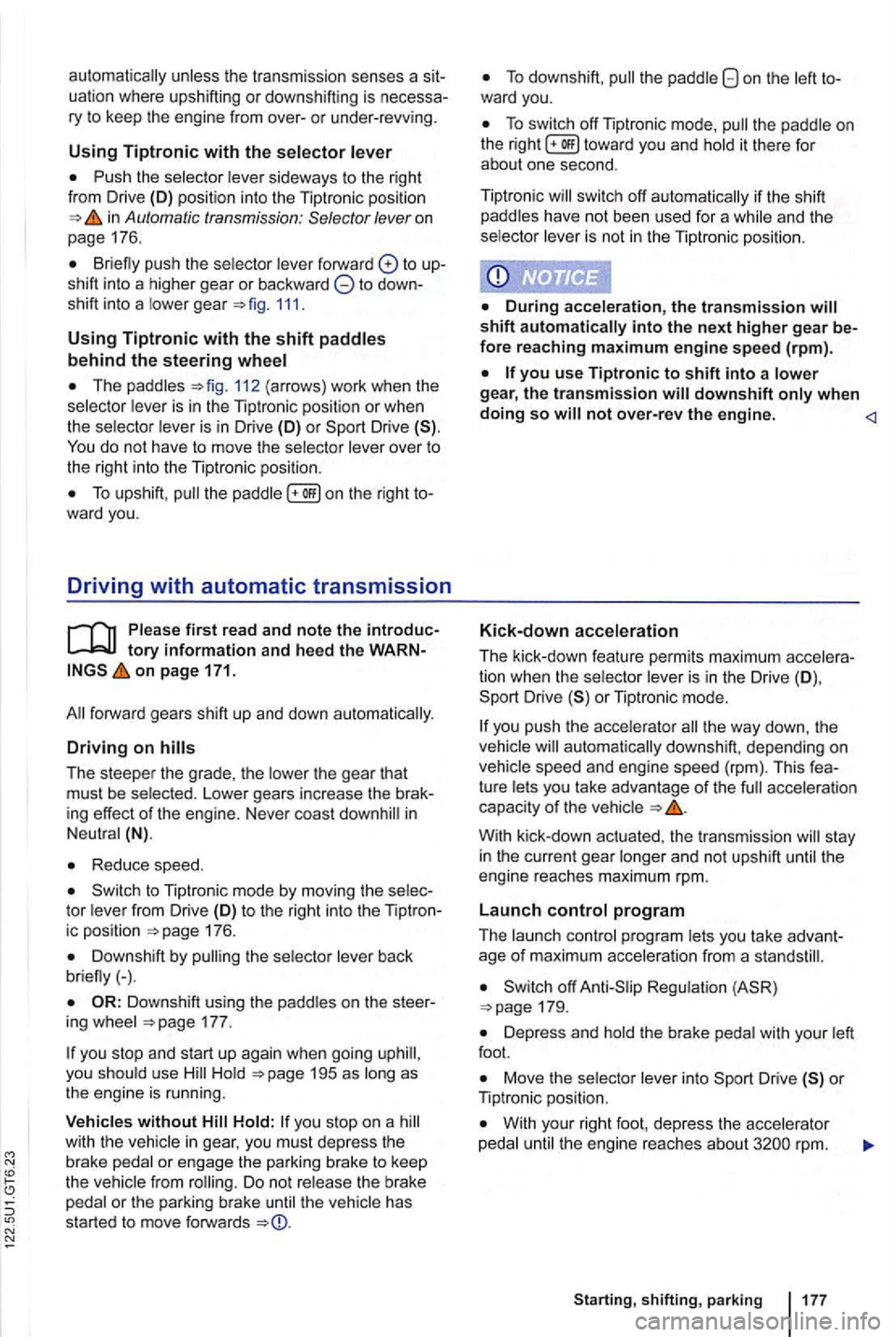
unless the transmission senses a sit
uation where upshifting or downshifting is necessary to keep the engine from over-or under-revving.
Using Tiptronic with the selector lever
Push the selector lever sideways to the right
from Drive (D) position into the Tiptronic position
in Automatic transmission :
Briefly push the selector lever forward to up
shift into a higher gear or backward to down
shift into a lower gear 111.
Using Tiptronic with the shift paddles behind the steering wheel
Th e paddles 112 (arrows) work when the
selector lever is in the Tiptronic position or when the selector lever is in Drive (D) or
To upshift, on the right to
ward you.
Driving with automatic transmission
on page 171.
in
Neutral (N).
Reduce speed.
Downshift by the selector l ever back
briefly(-).
Downshift using the paddles on the steer
ing wheel
you should use Hold 195 as long as the engine is running .
To downshift , on the left to
ward you.
To switch off Tiptronic mode,
switch off
shift automatically into the next higher gear be
fore reaching maximum engine speed (rpm).
you use Tiptronic to shift into a lower gear, the transmission not over-rev the engine.
The kick-down feature permits maximum tion when the selector lever is in the Drive (D ), or Tiptronic mode.
you push the accelerator automatica lly downshift , depe nding on
vehicle speed and engine speed (rpm). This
With kick-down actuated, the transmission
Regulation 179.
Depress and
Move the selector lever into Driv e or Tiptronic position.
With your rig ht foot, depress the accelerator
peda l until the engine reaches about rpm.
shifting, parking
Page 292 of 516

Flashes Possible ca use Proper response
Electronic steering column lock malfunction . The ignition cannot be switched on. The vehicle
system stiff.
column not locked I unlocked .
When the
ignition is switched severa l warni ng
a n d indicator lights come on briefly for a function
check . T hey go out after a few seconds.
Failure to heed warning lights and instrument cluster text messages can ca use the vehicle to break down sion and serious personal injury.
tory Information and heed the on page 192.
To
tomatic transmiss ion vehicle.
press the starter button briefly twice in a row
without depressing the brake or clutch pedal.
D o
not drive any farther if the steering column
remains locked after you switch on the ignition.
Get professional assistance.
Always stop the vehicle as soon as it is safe to do so.
F a
ilure to heed warning lights or text can resu lt vehicle damage .
Engaging the steering
co lumn lock
Park ing the vehicle
ing column lock
Turn the steering wheel
slightly to take pressure
off the steering column
l ock .
to the ignition switch.
Hold the steer ing wheel
i n this position and turn
the ignition switch.
Power steering automatically adjusts to driving
speed , steering torque, and the steering angle
of the wheels . Power steering works only when the
engine is running .
it
Sta rting, sh ift ing , park ing
Page 293 of 516
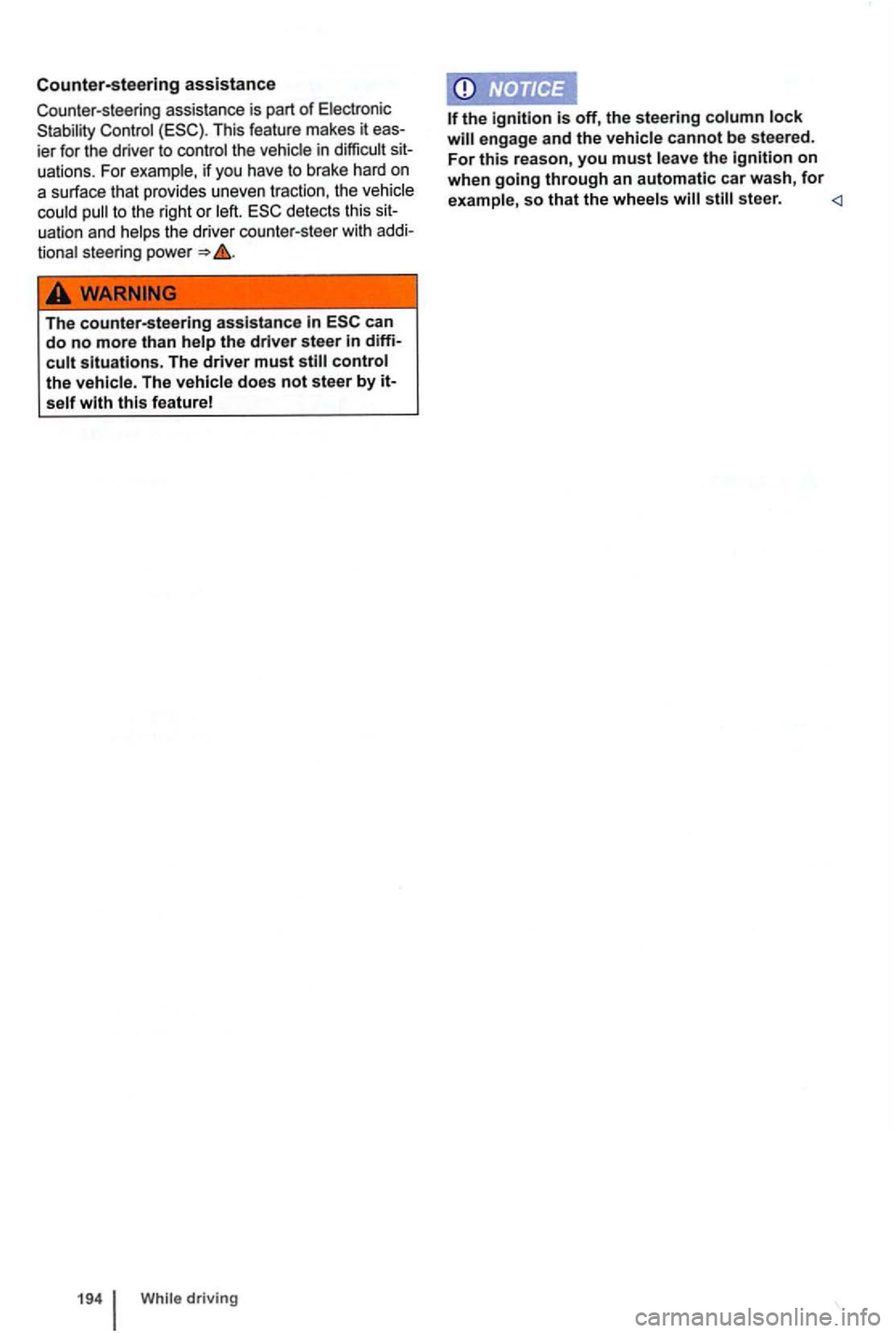
Counter-steering assistance
Counter-steering assistance is part of Electronic
Stability Control (ESC). This feature makes it ier for the driver to control the vehic le in difficult
uation and helps the driver counter-steer with
The counter-steering assistance in can do no more than help the driver steer in
self with feature!
194 driving
the ignition is off, the steer ing column lock engage and the vehicle cannot be steered. For this reaso n, you must leave the ignition on
when going through an automatic car wash, for example, so that the wheels will still steer.
Page 388 of 516
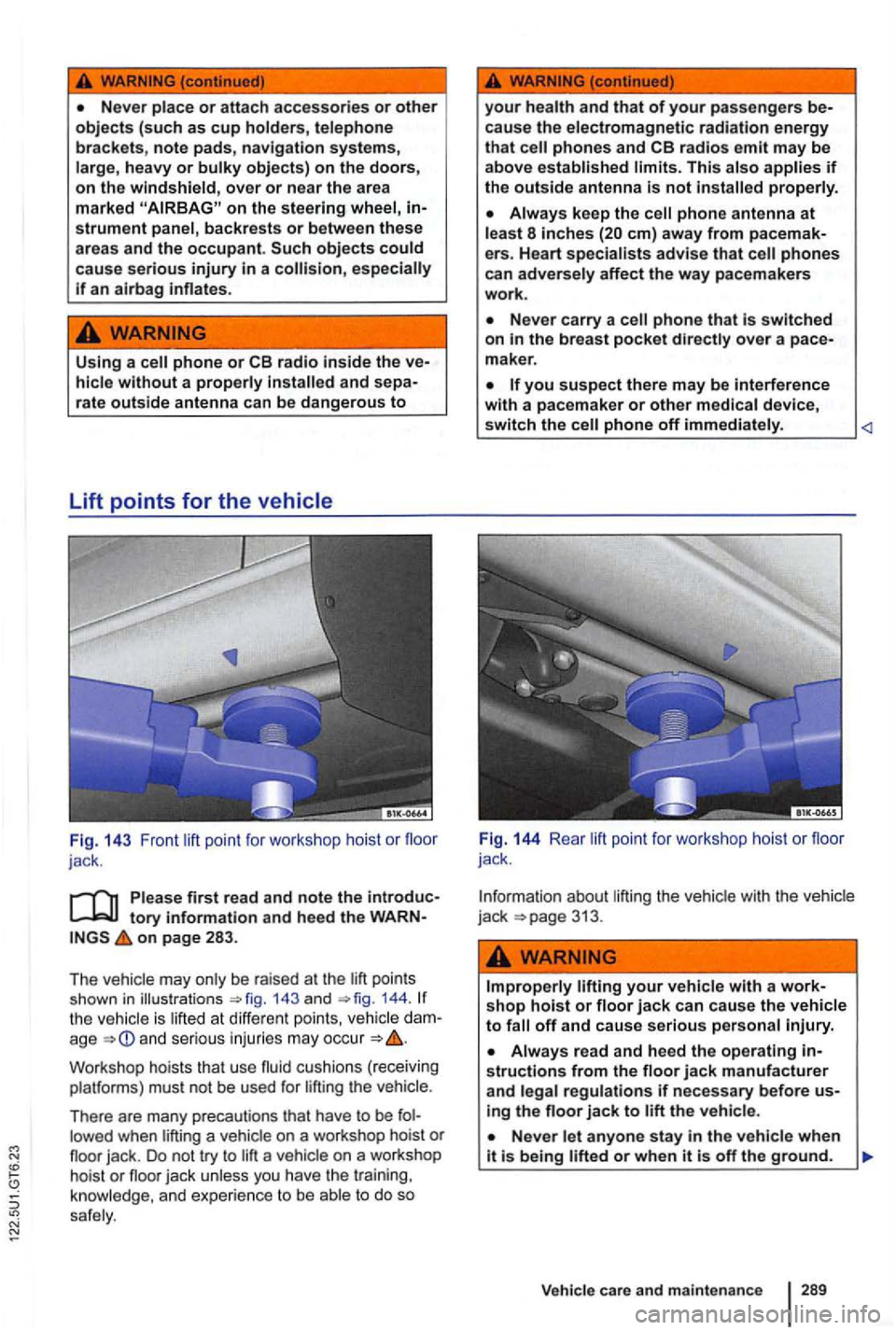
on the steering wheel, instrument panel, backre sts or between these
a reas and the occupant. objects could cause serious injury in a
phone or and sepa
rate outside antenna can be dangerous to
Fig. 14 3 Front point for work sh op hoist or floor
jack .
tory information and heed the WARNon page 283 .
The 143 an d 144 . the is lift e d at diff erent po ints, dam
age and ser io us injuri es ma y occur
Works hop hois ts that use fluid cushion s ( rece iving
platfo rms) must n ot be used for lifti ng t he
There are many precautions that have to be fol
lowed when lifting a vehicl e on a workshop hoist or
your health and that of your passengers be
cause th e e lectromagnetic radiation energy
that phones and limits. This a lso p roperly.
Always keep the em) away from pacemak
e rs. Heart phones can adverse ly affect the way pacemakers work.
Never carry a phone that is switched on the breast pocket directly over a pace
maker .
you suspect there may be Interference with a pacemaker or other medical device, switch the phone off immediately.
Fig. 144 Rea r lift point for works hop hois t or floor jack .
I n formation about liftin g t
he veh icle with the
Improper ly your vehicl e with a workshop hoist or floor jack can cause the vehicle to off and ca use serious per son al Injury.
Always read and heed the operating structions from the floor jack manufacturer and legal regulations if necessary before using th e floor jack to the vehicle .
Never let anyone stay in the vehicle whe n
Vehicle care and maint enanc e
Page 429 of 516
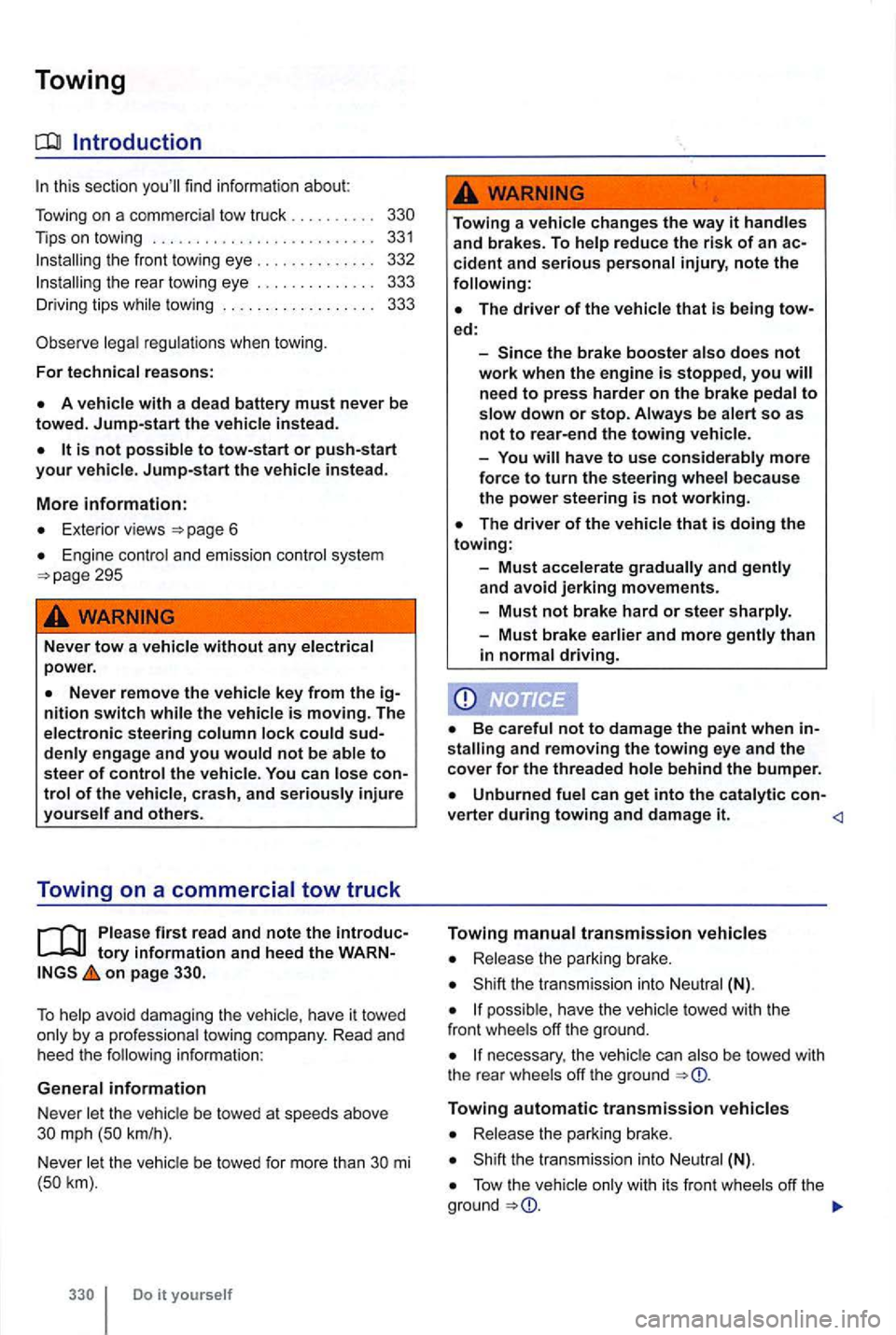
Towing
this sectio n you 'll find informat ion about:
T owing on a comme rc ia l tow truc k . . . . . . . . . .
Tips on towing .......................... 33 1
Installing the front tow ing eye . . . . . . . . . . . . . . 332
Installing th e rear towing eye . . . . . . . . . . . . . . 333 Driving tips towing 333
Exterior views
295
WARNING
Never tow a vehicle without any electrical
power.
denly engage and you would not be able to steer of control the vehicle. trol of the vehicle, crash , and seriously injure yourself and others.
Towing on a
on page
To help avoid damaging th e vehicle , h ave it towed
o n ly by a professional towing company. Read and
heed the following
information:
General information
N ever let the vehic le be towed at speeds above
km).
Towing a vehicle changes the way it handles
and brakes . To help reduce the risk of an cident and serious personal injury, note the following:
ed:
-
will have to use considerably more
force to turn the steering wheel because
the power steering is not working.
stalling and removing the towing eye and the cover for the threaded hole behind the bumper.
Towing manual transmission vehicles
Release the parking brake .
the transm ission into Neutral (N).
necessary, the vehicle can also be towed with the rea r wheels off the grou nd
Towing automatic transmission vehicles
Release the parking brake.
the transm issio n into Neutral (N).
Tow the vehicle only with its fron t wheels off the
gro und
Page 430 of 516
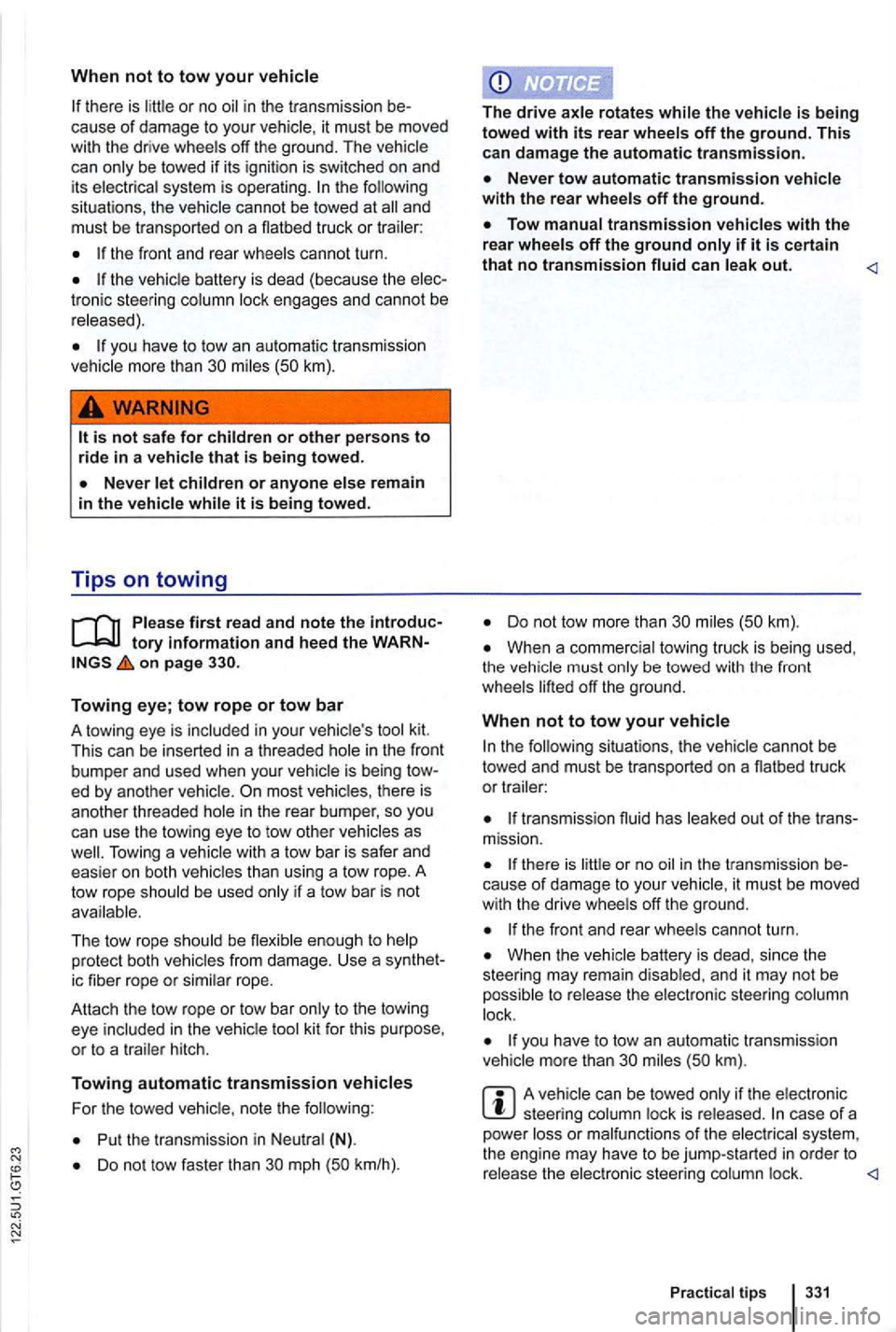
When not to tow your
there is in the tr ansmission be
cause of damage to you r it must be moved
with the drive wheels off the ground . The vehicle
can only be towed if its ignition is switched on and
i ts electrica l system is operating. the following
situat ions, the vehicle cannot be towed at
the front and rear whee ls can not turn .
the vehic le battery is dead {because the elec
troni c steering column lock engages and cannot be
r e leased).
you have to tow an automatic transmission
vehic le more than 30
first read and note the introduc
on page
Towing eye; tow rope or tow bar
A towing eye is included in your vehic le 's tool kit. This can be inserted in a threaded hole in the front
bumper and used when your vehicl e is being tow
ed by ano ther vehicle.
The tow rope should be flexib le enough to he lp
protect both vehicles from damage. Use a synthet
ic fiber rope or similar rope .
Attach the tow rope or tow bar only
to the towing
eye in the vehic le
For the towed vehic le, note the following :
Put the transmission in Neu tral (N) .
Do not tow faster than 30 mph (50 km/h). The
drive rotates while the i
s being towe d with its rear wheels off the ground. This can damage the automatic transmission .
can
Do not tow more than 30 miles (50 km).
When a commerc ial towing truck is being used,
the must be towed with the front
wheels
transmiss ion fluid ha s out of the trans
mission.
the re is in the transmissio n be
cause of damage to your vehicle, it must be moved
w ith the drive whee ls off the ground.
the front and rear whee ls cannot turn.
When the vehicle battery is dead , since the
steering may remain disabl ed, and it may not be
poss ib le to rele ase the electronic steering column
lock.
you have to tow an auto matic transmiss ion
veh icle mor e than 30 miles (50 km).
A veh icle can be towed only if the electronic steer ing column lock is r e leased. case of a
power system,
the engine may have to be jump-started in order to release the electronic steering column lock .
Page 444 of 516
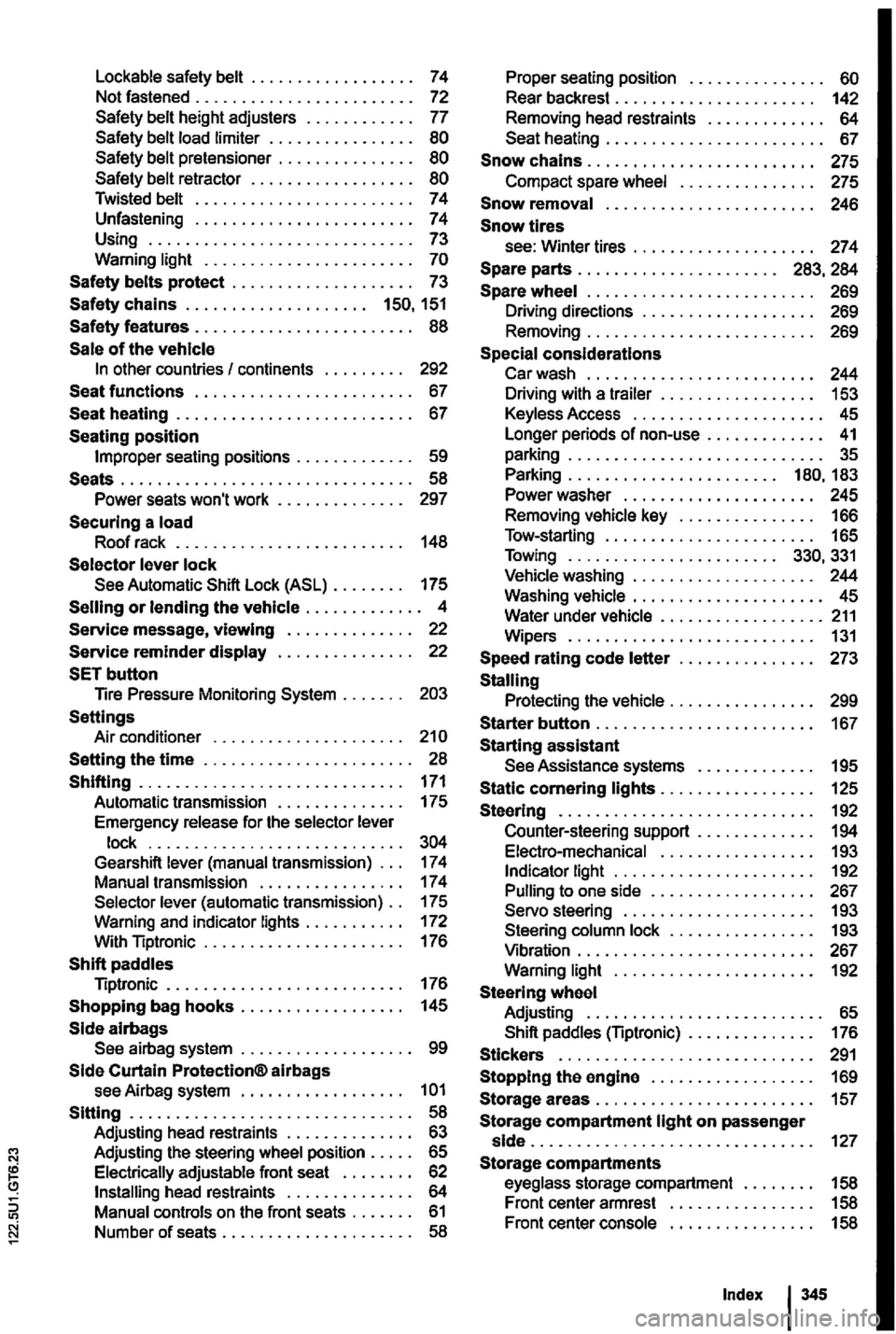
Lockable safety belt . . . . . . . . . . . . . . . . . . 7 4
Not fastened . . . . . . . . . . . . . . . . . . . . . . . . 72
. . . . . . . . . . . . . . . .
. . . . . . . . . . . . . . . . . . . . . . . . . . . . . 171
Automatic transmission . . . . . . . . . . . . . . 175
Emergency release for the selector lever
lock . . . . . . . . . . . . . . . . . . . . . . . . . . . .
. . . . . . . . . . . . . . . . . . . . . . . . . . . . . . . 58
Adjusting head restraints . . . . . . . . . . . . . . 63 Adjusting the steering wheel position . . . . . 65 Electrically adjustable front seat . . . . . . . . 62
. . . . . . . . . . . . . . . . . . . . . . . . . . . . 192
Counter-steering support . . . . . . . . . . . . . 194
Electro-mechanical . . . . . . . . . . . . . . . . . 193